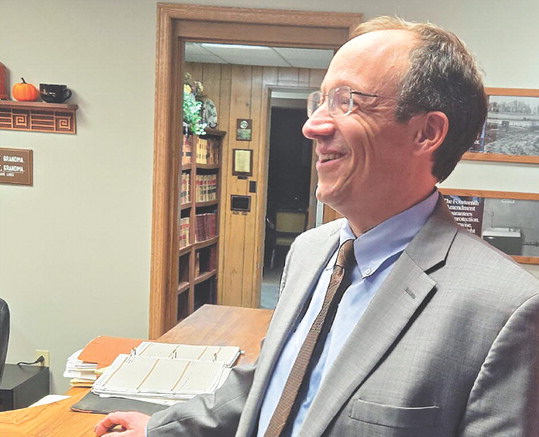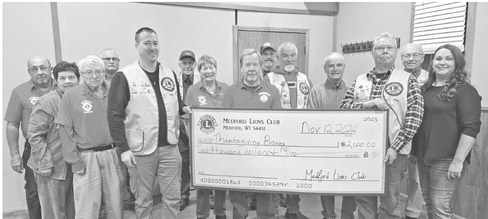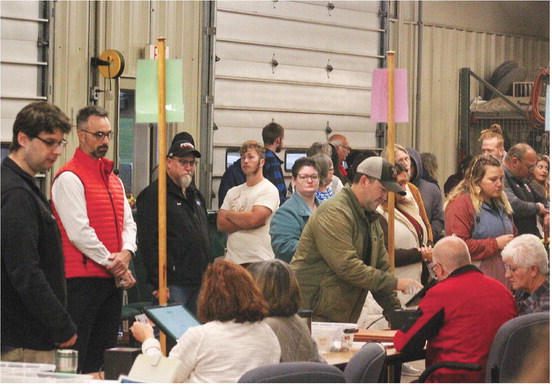‘Extremely good news’
Spencer school in line for another $517,000 in FEMA funding
With any luck, figured Spencer Board of Education President Jordan Buss, the school district might be able to shake loose an extra $10,000 or $15,000 in funds related to the Federal Emergency Management Agency (FEMA) grant that helped pay for its 2021 dome construction project. How about more than a half-million dollars?
That apparently is the amount the district will receive soon in what District Administrator Mike Endreas last week called “extremely good news.” The news came in time for the Board of Education to consider the extra money in its 2023-24 budget, with early ideas for its use including possible expansion of the Rookie Rockets day care center operation or to pay down the debt associated with the recent building project.
At an Oct. 19 monthly Board meeting, Buss said the state emergency management agency the district has been working with on the FEMA grant award has told the school it is in line for $517,650 in additional FEMA funding, on top of the $2,926,153 the district has already received. The first grant paid for the concrete dome construction as a community emergency storm shelter, and the district spent additional referendum-approved dollars for related facility improvement projects, including a fitness center, wrestling area, classroom expansion, etc.
Now, Buss said, extra funds have become available because another community in Wisconsin that also was to receive a storm shelter grant decided to decline it when total costs for its project were higher than expected. Spencer completed some paperwork “in the off chance” that such funding might become available, and it now appears the $517,650 is headed Spencer’s way.
“We have not received confirmation of whether those funds will be approved,” Buss said, but the state emergency agency did allow the district to publicly announce the award ahead of its Nov. 1 budget approval deadline.
“All indication is the district can expect to receive the $517,000,” Buss said last week.
Buss said the district has received all of the $2.93 million from the earlier FEMA grant program. Only construction costs directly related to the storm shelter construction were eligible for FEMA dollars, but those costs actually came in $723,000 higher than expected due to increased material costs. Still, the grant was capped at the $2.93 million, but Buss said the district filed a claim for the extra eligible costs “on the very slim chance that additional funding would be made available.” Spencer purposely did not officially close out its grant project, Buss added, “just on the off chance another project had a cost underrun.”
Lo and behold, the funding did become available when the other community turned down its dollars. Spencer learned the amount on Sept. 6, but not officially.
“We had to keep it to ourselves,” Buss said.
Spencer did, however, ask for permission to announce the award now, so it can include the extra funds in 2023-24 budget plans.
One option the Board’s facility committee has already discussed is expansion of the Rookie Rockets operation to include infants and toddlers. When it was planning for the referendum construction work, one of the projects it planned was to enclose an open courtyard area in the center of the elementary building for the Rookie Rockets center. However, Endreas called the courtyard “a money pit” that would have cost too much to renovate.
“It was not worth the amount of money that would have had to be put in there,” he said.
With that decision, the Rookie Rocket center did not gain the space it needs to expand its population to infants and toddlers. However, the need for such care is still needed in the Spencer community, Endreas said, and the district would be able to pull in more revenue by expanding.
“We are losing on average eight to 10 kids a year to Marshfield for day care,” Endreas said.
Part of the value of the Rookie Rockets center to the district is that families who take their kids there are more likely to enroll them in the Spencer school rather than open-enroll them elsewhere. A school-based care center is also an attractive asset for families looking to move to town.
The facility committee asked two architectural firms for rough plans on what an infant/toddler facility would look like. Endreas said the plans are for new construction on the south end of the elementary building. State codes require that an infant/toddler facility have direct interior access, so a stand-alone building would make sense.
The one plan the district received was for a 3,000-square foot building, with an estimated cost of $950,000.
The $517,000 in FEMA funds could be used for that expansion, and the Board last week approved a 2023-24 budget plan to generate extra funds for it. Due to a hefty rise in property value in the district, the tax rate for the next budget was projected to fall to $7.80 per $1,000 of value, from the $8.47 level the district projected when last year’s revenue cap exemption referendum was approved. Rather than decrease the tax rate this year and then raise it next year and create “a roller coaster of tax levies,” Endreas recommended the Board set the levy rate at $8.47 as anticipated. That would generate an additional $220,000 in tax dollars, he said, which could be used for a Rookie Rocket expansion project. Endreas said the move would not bind the board to the Rookie Rocket project, but would keep the option open “if you have any desire to investigate the infant care piece.”
The Board accepted the recommendation and set the tax rate at $8.47.
Board member Becky Gorst said the care center expansion could be valuable in years to come if families bring their kids to Spencer.
“Ten kids for 12 years of their life is a lot of money to the district,” she said.
Other Board members talked about the need for infant care in the community. Principal Jason Gorst said it is diffi cult for young parents to find adequate care for their little ones.
“Right now we have teachers that are driving 35 or 40 miles one way to drop off their kids,” he said.
If the Rookie Rocket project does not come to fruition, Endreas said another option for the FEMA dollars would be to pay down debt from the dome project. By applying the $517,000 and the $220,000 in additional taxes this year, the debt could be repaid by 2030, he said.




